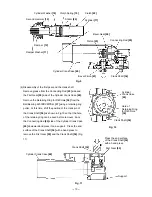
--- 12 ---
Slip clutch mechanism
The slip clutch mechanism is described below with reference to Fig. 5. The bevel pinion and the gear holder
are coupled together by the key and press-fitting. Spring (C) and needle pins are housed in elongated
grooves of the gear holder. The needle pin is pressed against the inner face of second gear by spring (C) to
allow idle rotation of the second gear relative to the gear holder. When an excess torque is exerted on the
bevel pinion shaft, the needle pin is raised upon the projection of the second gear against the load of spring
(C) to allow idle rotation of the second gear. With the arrangement, the clutch slips when an excessive torque
is applied to the working tool as when the drill bit contacts steel bar/wire in the concrete, protecting the
operator from unexpected motion of the side handle.
Bevel pinion
Needle pin
Bevel pinion
Gear holder
Gear holder
Second gear
Key
Spring (C)
Gear holder groove
Fig. 5
Cross section A - A
A lever-type retainer is employed to permit easy one-touch
mounting and removal of drill bits, bull points, etc.
As illustrated in Fig. 6, pull the knob in the direction indicated
by arrow a , and turn it 90˚ counterclockwise (arrow b
direction) to align it with the alignment mark on the front
cover. Insert the tool shank fully into the spline hole in the
front cover, and return the knob to its original position. The
tool is then securely attached.
Tool holder
Knob
Alignment mark
Front cover
Fig. 6
Handle and side handle
The handle section is of a two-layer structure. The base is made of glassfiber-reinforced plastic and the
outside layer is soft resin. They are molded in one piece.
The side handle also has a two-layer structure. The base is made of glassfiber-reinforced plastic base with a
steel nut and the outside layer is soft resin. They are molded in one piece. The newly designed handle and
side handle structure ensures more comfortable grip for improved operability.
Tool
A
A
Содержание DH 40FR
Страница 30: ......
















































